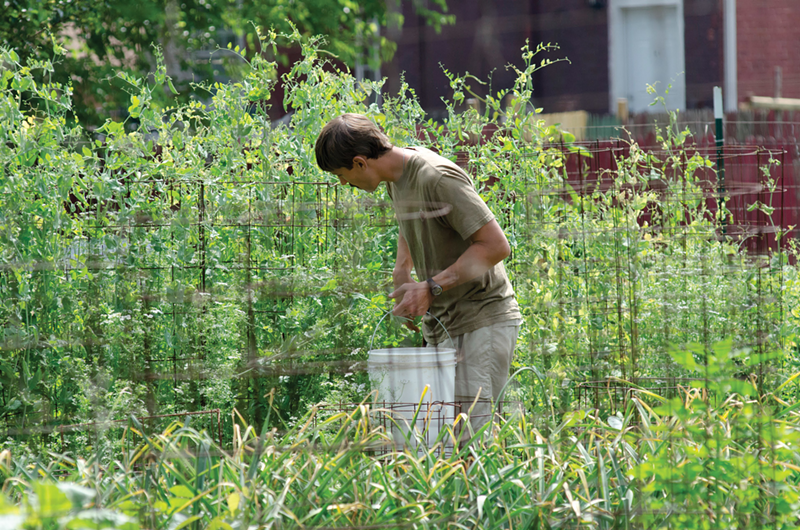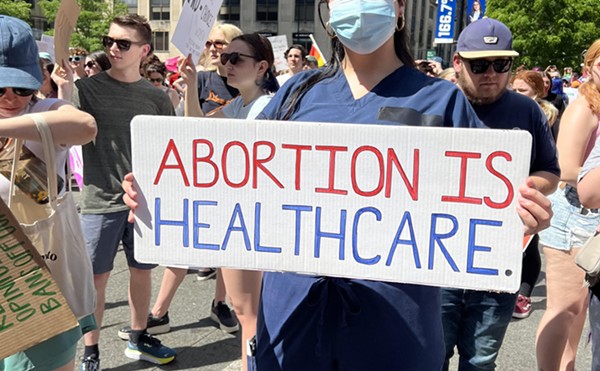W
hen grocery store chain Aldi shuttered the doors of its Avondale location in 2008, the neighborhood didn’t just lose a community business. It lost a slice of its livelihood.
That loss abruptly morphed the neighborhood into what’s considered a “food desert,” defined by the U.S. Department of Agriculture (USDA) as a geographic area deprived of ready access to affordable, fresh fruits, vegetables and other healthy foods. Since then, the new “grocery stores” have become corner stores, gas stations and fast food joints.
It hasn’t kept Avondale resident Moses Johnson, 55, from leaving his neighborhood, but it’s made life a lot more difficult.
“We were used to doing all our shopping in the neighborhood, right in walking distance,” says Johnson, who, like most
Avondale residents, relies on the bus to get around. “That walk turned into miles.”
Johnson, who is a vegetarian, is willing to make the bus trek every two weeks for his grocery trip so he can get fresh fruits and vegetables, but he’s more of the exception than the rule.
“Food deserts” aren’t barren. In fact, food is typically plentiful, according to Michael Widener, assistant professor in University of Cincinnati’s Geography Department. It’s that the options at places like corner stores — preservative-filled, nutrient-vapid foods — are the standard, and, because food deserts tend to pop up in lower socioeconomic areas often riddled by crime and poverty, preparing healthy meals isn’t a primary concern.
Diets lacking fresh fruits and vegetables cause myriad health problems, including obesity, heart disease and diabetes. Unsurprisingly, a report from Cincinnati’s Fresh Food Retail Financing Fund, established by the city’s Food Access Task Force, found strong overlaps between areas with low income and low supermarket sales and those with high levels of diet-related deaths and limited supermarket access. Avondale is a prime example.
Food deserts are so complex that researchers like Widener are rethinking the way they’re characterized, hoping to understand what causes them to fester. He’s currently working on research that could redefine the way food deserts are mapped, based on daily commuting routes and travel habits.
“We’re assigning general characteristics to regions that have very diverse populations,” says Widener. “There’s a lot more work that needs to be done. … We really need to know where and who are being affected by inaccessibility to healthy foods.”
Soon, he hopes to release interactive transit maps that will show how long it takes using Southwest Ohio Regional Transit Authority (SORTA), which runs the city’s bus and transit system, to access grocery stores across the city.
He’s still working on analyzing how broader economic factors, like poverty and education, affect both eating habits and food desert allocations, which could eventually help policy-makers understand what’s working and what isn’t. In the meantime, leaders across Cincinnati are slowly working to patch the holes.
Late last summer, Councilwoman Laure Quinlivan spearheaded City Council’s approval of the establishment of several mobile produce zones plotted in eight neighborhoods generally considered food deserts, including Camp Washington, Fairmount, East End, Evanston, Northside, Westwood, West End and Winton Hills.
On June 8, she officially re-launched the program for the summer season. The 13 “zones,” placed purposefully in high-traffic areas like outside of schools and recreation centers, offer spots for vendors to sell produce they’ve grown themselves or create partnerships with local farmers.
Quinlivan admits the zones are a stopgap. But it’s a start, agrees Widener, who says the zones could help quickly, easily expose populations to foods they aren’t familiar with, which might make them more inclined to seek them out in the future.
Ironically, neighborhoods most in need of permanent solutions — brick-and-mortar supermarkets — have trouble attracting grocers; it’s a matter of dollars and cents. “I don’t think that the supermarket industry is being malicious. ... They’re just following market trends,” Widener says.
Because grocery stores tend to have a low profit margin, selling accessories you’d find at a “super” Kroger (more luxurious items like gourmet cheese, magazines, etc.) is the best way to earn profits. Residents in places like Avondale typically don’t have the disposable income to buy products like these, so branches in food deserts aren’t often successful, even if they’re high-traffic. That’s the catch-22: A grocery store location in a food desert isn’t necessarily valuable to the chain, even if it’s the most needed.
The Center for Closing the Health Gap (CCHG), a nonprofit advocating health equality, was recently awarded $15 million by the city of Cincinnati for development of the Cincinnati Fresh Food Retail Financing Fund, which will be used to create incentives to attract grocery stores to underserved neighborhoods with tax credits or grant and loan programs. They’re currently working on identifying which stores would be eligible for funds.
The Over-the-Rhine Vine Street Kroger location, says Widener, is a perfect example of an underutilized urban grocery store. Cincinnati, currently undergoing its own urban revival, still has a few kinks to work out in readapting to a vibrant urban core.
Places like Avondale are seeing some small changes, though. In fall 2012, the Greater Cincinnati Foundation awarded CCHG a two-year, $150,000 grant for the “Do Right! Healthy Corner Store Initiative,” which is working to increase the availability and visibility of health foods in small-scale convenience stores. The CCHG now works with Avondale’s Gabriel’s Place, a community kitchen, garden and gathering place, to supply produce to nearby corner stores. So far, it seems to be helping. “When the corner stores set out produce, they can’t keep the bins full,” says Johnson, the Avondale resident. “It all disappears so quickly.”
Johnson sees hope for the neighborhood, which he’s considered home his whole life.
“This is great place, I know everybody and everybody knows me,” he says.
He mentors a young Avondale boy in hopes of giving back to the community that’s given him so much.
“I want him to see things he may have never seen before — that he can be anything he wants to be,” he says. “I want him to know that all things are available to him.”
Even fruits and vegetables. ©






